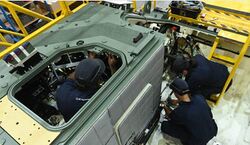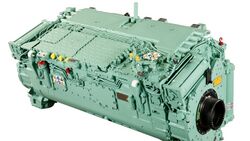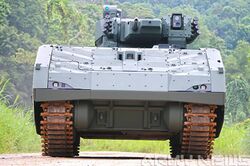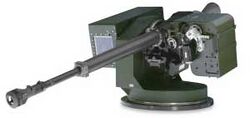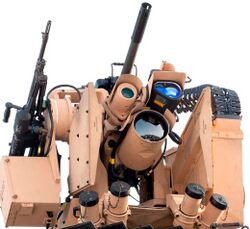C220 Rocinante II
This article is incomplete because it is pending further input from participants, or it is a work-in-progress by one author. Please comment on this article's talk page to share your input, comments and questions. Note: To contribute to this article, you may need to seek help from the author(s) of this page. |
| C220 Rocinante II | |
|---|---|
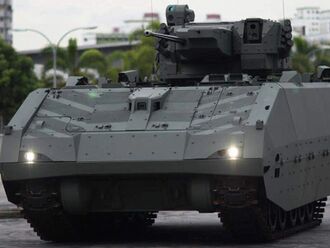 A C220-A on display at ALTAREX 2020 | |
| Type | Armoured fighting vehicle |
| Place of origin | |
| Service history | |
| In service | 2020-present |
| Used by | |
| Production history | |
| Designer | Cavallero Heavy Auto |
| Designed | 1960-2018 |
| Manufacturer | Cavallero Heavy Auto |
| Produced | 2019-present |
| Variants | C220-A C220-B C220-C C220-AA C220-H C220-M |
| Specifications | |
| Weight | 20 tonnes (Level I: baseline armour) 23 tonnes (Level II: composite applique) 25 tonnes (Level III: composite & ERA) |
| Length | 5.2 m (17 ft) |
| Width | 3 m (9.8 ft) 3.8 m (12 ft) (Level-III applique) |
| Height | 2.6 m (8.5 ft) (min) 3 m (9.8 ft) (max) |
| Crew | 2-3 (commander/gunner & driver or commander, gunner, driver) |
| Passengers | 10 |
| Armor | Level-I: HHS strike face with Aluminium 8009 inner plate Level-II: applique ceramic composite armour Additional applique explosive reactive armour |
Main armament | C220-A: 1 × Arx AC-30-II 30×250 mm chain gun (remote turret), 1 × 8.6×70 mm co-axial machine gun C220-B: 1 × 40×53 mm grenade machine gun, 1 × 6.8×43 mm co-axial machine gun C220-C: 1 × 12.7×99 mm machine gun (remote weapon system) C220-AA: 1 × Arx AC-35-III 35×228 mm chain gun, 2 × FIM-92 C220-M: 4 × MMP/MST-200, 1 × 8.6×70 mm pintle-mounted machine gun |
| Engine | Cavallero CAV-AFV220 twin-turbocharged 12.3-litre diesel V6 engine 500 hp (370 kW)/2600 rpm 550 hp (410 kW)/2800 rpm |
| Power/weight | Baseline: 22-25 hp/tonne |
| Transmission | Denk Hiswel G256 15-30 (automatic, 6-speed forward & reverse) |
| Suspension | torsion bar, 2 × set of 5 road wheels |
Operational range | A1 (Level-II): 385 km (239 mi) |
| Speed | Road: 70 km/h (43 mph) Wading: 5.8 km/h (3.6 mph) |
Steering system | Drive by wire |
The C220 Rocinante II is a Armoured fighting vehicle produced by Cavallero Heavy Auto. It is the product of a modernisation programme aimed at improving the older Matapon TOMP-IV Diokles, a Tagmatine Armoured Personnel Carrier. The vehicle entered pre-production in 2019 and entered service with the Iverican Army and the Republican Marine Regiments in 2020.
The C220 is a direct development based on the TOMP-IV, sharing its general chassis layout and silhouette. The vehicle was also designed to retain key design features from the Diokles, namely its relatively low mass and compact profile. It also incorporates advancements, featuring improvements centred on protection, sensor technology, drive train, and armament mounting. In Iverican service, the C220 is used to supplement parachute infantry, mountain infantry, breacher-engineer, and amphibious expeditionary units.
History
Cavallero announced the programme at the 1998 Altaria Arms Expo (ALTAREX) as the Rocinante Project and subsequently revealed the C200 Rocinante at the 2000 ALTAREX. Though originally announced as a technology demonstrator and competency showcase, repeated interest in the project prompted Cavallero to design a more advanced unit with the intention of mass production. The new design was entered in a 2008 preliminary bid to the Iverican Ministry of Defence as the C220 Rocinante II. The C220 design passed Ministry reviews in 2010 with Cavallero receiving second-stage funding for continued development by 2011. The vehicle entered pre-production in 2019 and entered service with the Iverican Army and the Republican Marine Regiments in 2020.
In later public commentary, Cavallero revealed that the Rocinante Project had not been intended for full production and had only received funds from the company's marketing budget and not its R&D budget. Cavallero revealed that initial funding for the C200 technology demonstrator had been $1.9 million ADS issued as a marketing initiative and had been constructed outside of the design team's billed hours, initially as a recreational project with a TOMP-IV chassis purchased from Ee-bay.
The C220's first iteration was the C200 Rocinante, also referred to as Rocinante I. The C200 was a single TOMP-IV Diokles purchased on Ee-bay and intended as a test bed and later, technology demonstrator for Cavellero Heavy Auto's technology showcase for the Altaria Arms Expos. From corporate communications, Cavallero mentions several reasons for TOMP-IV's choice. The TOMP-IV was a versatile, spacious vehicle with an aluminium chassis that was easy to cut and modify. From a marketing point of view, the TOMP-IV was a much beloved, combat-proven design widely recognised by civilian enthusiasts and military personnel. The ease of modification and recognisability of the TOMP-IV made it Cavallero's choice to showcase modules like their new remote weapon systems, optics, and design concepts.
In a 2020 interview with Cavallero CEO, Ouln Haswein, Haswein admitted that his company had received repeated contact from the Iverican Ministry of Defence and several foreign partners enquiring about the state of the C200 project. The enquiries had been follow-ups on Cavallero's 1998 ALTAREX promotional material which had a short paragraph introducing the C200 as a concept of a modernised, more survivable TOMP-IV. Though Haswein admitted that it was only written to set the context for the technologies mounted, the promotional flavour text had the unintended consequence of generating interest. Cavallero decided to pursue the prospect created by the interest and began work on an original design in 2001, completing a proprietary test bed in 2007 and winning a Ministry of Defence bid in 2010. After receiving funding for a joint-government ownership patent in 2011, Cavallero began late-stage design work and completed a pre-production prototype in 2013. In 2014, the C220 Rocinante II entered a limited production run for a series of public demonstrations with 5 vehicles. After passing final Ministerial and Parliamentary Committee reviews, the C220 entered full production in 2019 and was allowed to enter service in April of 2020.
Design
Cavallero intended for the C220 to offer modern technical solutions and design innovations to the proven but dated design of the TOMP-IV. Requirements from the Iverican Ministry of Defence called for an increase in survivability, an option to mount a main gun system of at least 25 mm, and the retention of the TOMP-IV's airmobile and amphibious capabilities. The C220 had to be rated for Level III of the Ministerial Armour Rating Standard, now equal to Standardisation of TRIDENT Agreement 4569 (STATAG 4569) Level 4. The tonnage requirement required a vehicle of no more than 25 tonnes at base combat weight, dimensions that could allow for internal airlift onboard a C-9 Toro, and a design that would make the base vehicle naturally buoyant with minimal modification.
Cavallero's final iteration of the C220 pre-production model passed review in December of 2018, passing all requirements. Design choices by the Rocinante design team were either enhancements of the tender requirements or concessions to accommodate the ministerial requirements. New material technology for the C220's lightweight composite armour package and composite rubber track system are notable enhancements that reduced the overall tonnage. Internal storage space was surrendered to create structural voids that balanced the C220's buoyancy. The C220's widened and stretched hull though approximately 400 cm longer and 300 cm wider, is still capable of fitting safely in a C-9. The requirement for a main gun mount was addressed by mounting the Geno III remote turret. Though originally designed for the Cavallero Ordnance 35 mm Rasger Autocannon, the design team refitted the Geno III for the 30 mm AC-30-II.
Since the TOMP-IV's entry into service in 1960, significant improvements in the reliability and efficiency of modules like the power plant and transmission allowed Cavellero to introduce a more powerful twin-turbocharged V6 plant and a computer-managed, automatic, torque converter transmission to replace the TOMP-IV's naturally-aspirated 6-cylinder and mechanical torque converter respectively. Advancement in armament technology also allowed for the mounting of lightweight remote systems where larger directly manned systems would have been necessary.
Mobility
Retaining a similar road wheel layout and size, a similar suspension system, and an identical drive train layout, the C220's drive system is a direct enhancement based on TOMP-IV's drive system. Modularly, its main differences include the track system, the power plant, and the transmission module. Minor changes include a more robust final drive gear set made from milled stainless steel alloy and road wheels with a new mould featuring lightening cuts.
Unlike the original production TOMP-IV's which could run amphibiously propelled in the water by their tracks, the C220 requires the use of modular propellers which can be slotted onto the rear of the vehicle. Two propeller modules act as outboard propulsion and can oscillate for steering. The C220's maximum speed while swimming is approximately 12 km/h (7.5 mph) using equipped propellers. The C220, like the TOMP-IV, is naturally buoyant and only requires the deployment of a front-mounted trim vane to stabilise the vehicle while underway. Separate voids in the vehicle hull allow for some level of hydrodynamic stability and allow the vehicle to remain buoyant if the hull has sustained light damage. The C220 cannot swim with additional levels of armour attached.
For mobility in shallower waters, the C220 may wade up to a depth of 2.4 m or 8 ft.
Unladen with ammunition or applique armour, the C220 may secured onto a Retrorocket-Assisted Parachute rig and subsequently dropped from an aircraft. The vehicle is also airmobile with dimensions allowing for 2 fully armed and armoured C220s to be airlifted by a C-9 Toro.
Running Gear
The primary difference in running gear is the replacement of steel tracks with a composite rubber track (CRT) system. The new CRT pair has a pitch of 190mm, a width of 390mm, and a height of 150mm (including the guide lugs and grousers), these tracks are wider than the T130E1 tracks used on the TOMP-IV. The CRT used on the C220 was designed and manufactured by DuraMat, which provides a similar design to Arx Arms Manufacturing for the UC-42 Léon and the UC-30 Pantera.
The C220's CRTs are comprised of a layered mesh of soft metals, rubber, plastics and fabrics. The construction of the tracks is laminated, with meshes layered together and reinforced by a range of composite materials including carbon fibre and carbon nanotubes, as well as longitudinal and lateral steel cords, or ‘belting’. Above and below the belting are multiple layers of steel mesh configured to resist track twisting and maximise the longitudinal torsional stiffness of the track matrix. The C220's tracks are designed for vehicles weighing up to 30 tonnes. It uses more than 12 separate rubber compounds with an overall composition of approximately 49% rubber, 29% steel and 22% composites. A range of rubber compounds are used throughout the track matrix, with stiffer compounds in the lug cores and softer, more pliable, and UV-resistant compounds on the surface. Those elements, interfacing with moving parts such as the surface of the drive lugs that engage with the drive sprocket, use compounds that have high resistance to abrasion, a low friction coefficient, and are self-lubricating. The typical life of CRT on the C220 vehicles of up to 28,000 kg is approximately 7,000 km up to a max of 9,000 km.
An auto-tensioning system reduces the probability of the CRTs becoming dislodged from the rest of the running gear. A pair of hydraulic-electric pistons can move the idlers to increase or decrease tension. The system uses a pressure sensor to ensure that track tension is always exact and remains constant throughout the track wear cycle. It also makes replacing an entire track system easier as the driver can remove tension entirely.
The relative softness of the CRT system reduces the C220's wear on road systems and civilian infrastructure, while also reducing the vehicle's overall mass and increasing fuel efficiency.
Power Pack
The CAV-AFV220 is a twin-turbocharged 12.3-litre V6 diesel engine providing a maximum governed output of 550 horsepower at 2,800 rpm. Naturally aspirated, the CAV-AFV220 provides a similar maximum power-to-weight ratio as the TOMP-IV. Factoring the twin-turbocharger, increases its maximum governed power-to-weight ratio on the C220 to 25 hp/tonne. The power plant is mounted on the front-right of the hull and is connected to the Hiswel G256 transmission which takes up most of the front lower glacis. The power pack forms an L-configuration around the driver's station. Insulation and vibration dampening are layered on the engine-side of the bulkhead separating the fighting compartment and the power pack.
The Hiswell G256 transmission drives 2 drive sprockets mounted at the fore of the running gear. Like the TOMP-IV's TX-100 transmission, the G256 is also an automatic transmission using a torque converter system. However, the G256 is a 6-speed transmission with 6 forward speeds and 6 reverse speeds and has a digital governor to control stage transitions and power translation. It uses a computer to interpret driver inputs to incrementally adjust speeds on either track for smoother turning and enables neutral steering The transmission is connected to the C220's drive-by-wire system. It has a dry weight of 1,500 kg and is rated to take a maximum engine power of 700 hp. The G256 can accept a maximum input rate of 4,000 rpm and is rated for vehicles between 15 and 30 tonnes.
Access to the transmission is enabled by panels at the bottom of the lower glacis plate. The power plant can be lifted out from the top deck of the vehicle, which has slotting mounts for a lifting arm. To reduce vulnerability, the C220 armour layout does not feature a removable front plate for power pack access. Instead, the power plant and transmission may be decoupled first and then slid out from a hatch in the passenger compartment, guide rails stored below the seats can be connected to slide the entire power plant into the passenger compartment and out the assault ramp.
Auxiliary power units can be mounted in the form of lithium-ion battery modules, which can be slotted in the vehicle flanks, behind the troop seating. The battery units are connected to the transmission and power plant for charging when not in use. With all battery slots filled, the C220s may have up to 10 kWh in auxiliary power for silent overwatch. For safety, the batteries are slotted into covered voids inside the vehicle armour to reduce the risk of crew exposure to battery fires.
Electronics and Crew Systems
A forward-facing array of 3 cameras is used to provide a 120° wide arc of viewing for the driver. The cameras are infrared sensitive and can be supplemented by Infrared (IR) headlights which are mounted alongside the visible white light headlights. The array can also use ambient IR light and reflections to intensify contrast for low observability during night driving. A set of rear cameras guides driving in the reverse gear. Using its 360° view, the system can project a generated top-down view of the C220 to the driver via LCD display. If the driving camera array is not mounted or is damaged, the driver can rely on a set of 3 pop-out episcopes within the vehicle or can raise his seat to drive the vehicle from an unbuttoned position.
All C220s are fitted for a set of 4 Lithium-ion battery arrays acting as Auxiliary power unit. The battery arrays are installed behind the passenger seating and can provide a total power output of 10-12 kwh depending on usage. The battery APU makes the C220 capable of true silent overwatch.
For communications, C220s come equipped with a Very high frequency combat-network radio with an extendable aerial that can be raised to a height of 3 metres. Platoon command variants may be equipped with a satellite communications antenna and may be enabled to access military data links like Nousphera. A Dahlbein Microtronics Opera-L IV ESM may be mounted for HF-UHF electronic listening, direction finding, and passive recording of radio frequency communication intercepts. The direction-finding estimate is accurate up to 6°. The mast is detachable and can be operated via an extension wire up to 30 m away from the vehicle. For closed-circuit communication, a dismounted person may use the Tank phone mounted on the rear right-hand side of the vehicle, above the right track mud guard.
Unlike Arx vehicles like the UC-42 Léon, the C220 comes equipped with an integrated electric Boiling vessel for heating food or beverages. The vessel is located under the auxiliary crew seat. The boiling vessel has a 5 litre volume and is capable of heating up to 10 RAS entrée-sized ration packets simultaneously. It has 4 heating modes which can be toggled by dial; keep-warm, low heat, medium heat, and boil. The vessel holds a removable stainless steel pot for direct cooking. The vessel's exhaust is piped outward through tubing connected to the CBRN overpressure system and is secured by a hermetically sealing lid. The front side of the boiling vessel contains fittings to hold cooking implements and tools, usually the Exersito series 2001 Man-portable Field Kitchen tools. The left side of the vessel features a small folding surface with collapsing legs that folds upwards to become a mini-counter.
Armament
The C220 can carry a wide array of weaponry. A remote turret can be mounted to admit main guns. Smaller remote weapon stations can also be mounted. Specialised variants include an ATGM launcher with a retracting missile rack or a mortar carrier with retractable mortar.
The C220-A variant uses an electrically traversed remote turret capable of mounting 20 mm, 25 mm, and 30 mm autocannons alongside a co-axial 8.6×70 mm machine gun. The turret mounts a FLIR or Forward-looking infrared-capable main gunsight, a masted low-profile independent thermal viewer, and 2 countermeasure launchers. The turret contains an integrated ammunition feed system that may carry a total of 320 30×250 mm rounds for the main gun and 800 rounds of ammunition of 8.6×70 mm. In a scenario where quick reloading is needed, the turret can traverse to allow a crew member access to a loading receiver on the turret bustle. Reloading is facilitated by inserting stripper clips of autocannon ammunition and feeding the gun via an electronic feed system or a backup mechanical system cycled by a detachable hand crank. Reloading may be conducted from the commander's cupola or the top deck passenger's shooting hatch in the rear. The Co-axial ammunition box must be reloaded from an access hatch above the remote turret.
Main Gun
C220-A variants are equipped with an Arx AC-30-II 30×250 mm chain gun inside a remote turret. The AC-30-II is a single-barrelled recoilless revolver cannon firing caseless telescoped ammunition.
The AC-30-II may be fed by a single belt of ammunition or double-fed with 2 different types of ammunition belts on either side of the weapon. The crew are capable of swapping between either belt via the fire control computer. On the C220, ammunition is primarily High-explosive incendiary (HEI) with a secondary belt of Tungsten Armour-Piercing Fin-Stabilised Discarding Sabot (APFSDS) though any ammunition type compatible with the AC-30-II can be loaded, including 30 mm High-explosive Dual Purpose (HEDP) and Air-Burst Programmable Fuse (ABPF) types. Both belts feeding the gun can contain a total of 320 rounds of 30 mm ammunition or 160 rounds per belt. The belts may be mixed with demonstrator model cross-sections shown with one belt loaded initial 120 rounds of APFSDS ammunition followed by 40 rounds of HEI. The interior feedways are also configurable, featuring a secondary option to have 1 longer 200-round belt alongside a shorter 120-round belt.
Secondary Weapons
A variety of weapons can be mounted on pintles or on remote weapon stations. On turretless versions, the commander's cupola is fitted with a mounting arm for either a general-purpose machine gun, a heavy machine gun, or an ATGM launcher. The large passenger's shooting hatch on the rear deck of the vehicle can accommodate 2 passenger shooting positions and can be fitted with mounts for GPMGs on either side.
Other C220 variants such as the C220-B be equipped with a 40×53 mm grenade machine gun alongside a 6.8×43 mm co-axial machine gun in a compact weapon turret. Single-weapon remote systems can also be mounted to equip 14.5 mm, 12.7 mm, 8.6 mm, and 7.62 mm machine guns.
On the C220-A variant's turret, a folding rack of 2x MMP/MST-200 ATGMs can be mounted for use against armoured targets or slow, low-flying aerial targets.
Fire Control
Control of the remote stations is conducted from within the vehicle. A bulkhead separates the passenger and crew fighting compartment, which consists of a driver's station, a commander's station and a third auxiliary station for either a gunner or another type of crew member. Both the commander's station and the auxiliary stations are equipped with display panels and controls to operate the vehicle's remote weaponry. Both stations can share overlay markings and display picture-in-picture views across terminals.
The main gunsight is a 3rd-generation FLIR camera with an integrated laser rangefinder. The telescopic lens is capable of 25x optical zoom or 40x optical zoom depending on the variant used. It is connected to a Fortis Fusiliero-III fire control computer which generates the user interface and digital overlay to crew terminals. The commander can operate this system from his seat inside the main passenger compartment via a remote terminal. The Fusiliero-III is C4I integrated and can send and receive information from the Nousphera network. The commander may also have access to an integrated DorTak Battle Management Terminal which can display Blue Forces Tracking information.
If needed, the commander can observe the vehicle's surroundings in person by using a cupola located behind the driver's hatch. The cupola features a set of 8 episcopes for viewing a 225° arc around the vehicle. For observation inside, the commander's terminal can be used to operate a retractable gimbal camera mounted on the turret. The gimbal independent thermal viewer (ITV) can rotate 360° and pitch from -60° to 90°. The gimbal ITV mount can extend 1.2 metres above the turret height and is FLIR-capable.
Protection
Baseline armour protection consists of lightweight composite made from laminated steel and aluminium. This base armour structure is capable of resisting penetration from repeated strikes from 14.5×114mm AP / B32 at 200 meters with 911 m/s. The C220 can be fitted with 2 additional applique armour packages equipable in the field. Mountings for soft-kill grenade countermeasures and hard-kill Active Protection Systems are also available. The overall crew and passenger safety is also enhanced by newer fire suppression systems, a spall liner layer and choice materials that reduce the fire hazard present in the TOMP-IV's 5083 aluminium alloy construction.
Secondary protection measures include countermeasure grenades which can fire smoke & chaff munitions, tear gas, or infrared dazzling munitions. The C220 is also equipped with CBRN protection and is designed to protect its crew from liquid incendiary or airborne hazards. Passive electronic systems can also be mounted. For urban or counter-insurgency operations, the RI/VLQ-12 CREW Jammer is mounted. 4 laser warning receivers on the corners of the vehicle passively detect infrared emissions and can cue countermeasures or active systems.
Armour Packages
- Level-I consists of 30-46 inches of composite armour. A lightweight armour system is used, comprised of a High-hardness Steel strikeface that contributes to approximately 33% of the plating's thickness, a thin elastomer intermediate layer, and an aluminium 8009 base layer. The aluminium alloy used is rated to withstand high temperatures and is less flammable than other aluminium alloy grades. A final fibre-resin spall liner is applied to the interior of the armour plating. Level-I protection passes Standardisation of TRIDENT Agreement 4569 (STATAG 4569) Level 4.
- Level-II armour is mounted on the fore and flanks of the vehicle. These applique panels are a lightweight assembly of soft steel and a corrugated arrangement of ballistic ceramic plates affixed on a steel frame and backed by aluminium foam. Level-I protection passes Standardisation of TRIDENT Agreement 4569 (STATAG 4569) Level 6.
- Level-IIIE armour consists of explosive-reactive armour segments containing flyer plates. This can be mounted over the Level-I or II armour and primarily serves to detonate the initial charge of tandem-shaped-charge weapons or to destabilise a kinetic penetrator. This array of small ERA cells is rarely mounted on C220's expected to operate near dismounted infantry.
- Level-IIIN armour is a Non-explosive reactive armour (NERA) package mounted as large blocks around the vehicle. The interior of each block 3 layers of laminated NERA plates sloped at 60°. Each plate consists of a polycarbonate jacket, hardened ceramic plates, aluminium foam, and elastomer. The plates are held in place by steel brackets and an outer structure of aluminium. Relative to Level-IIIE, Level-IIIN is intended to be a safer alternative for dismounted infantry operating alongside vehicles.
Active Protection Systems
3 active protection systems have been tested on the C220, although deployment on currently serving Republican Armed Service C220s appears to be non-standard. Current APS mounts on the C220 necessitate the installation of the vehicle's battery pack APU modules or require the main power plant to be idling for active use. Current variants of the C220 require external modification to mount larger guidance systems like the RI/VPG-040 radar or the Sense-6 Block I or Block II.
A gimbal-mounted Sauron Directional Infrared Counter Measure (DIRCM) dazzler unit from Dahlbein Defence can be mounted on the C220. The DIRCM acts as an electro-optical disruptor against range-finders, designators, and ATGMs reliant on laser guidance or infrared homing. Using the C220's integrated Laser Warning Receivers for guidance, the DIRCM module can be used to reduce the accuracy of incoming laser-guided or infrared-homing munitions. The gimbal mount articulates 360° and the dazzler head can pitch at 180°. If present, the whole DIRCM unit is encased in a ballistic glass dome atop the turret on turreted variants and behind the commander's hatch on non-turreted variants.
The C220 is currently being tested for compatibility with the Arx-Fortis Sense-6 Block II multifunction infrared system which has a soft-kill APS feature.
Dahlbein Defence's Interfector APS can also be mounted on the C220. Interfector is a hard-kill system that utilises explosively formed penetrators (EFP) guided by an F/G-Band fire-control radar. The RI/VPG-040 guiding the system's 2 launchers is a four-faced distributed active electronically scanned array Pulse-Doppler radar designed to detect and automatically track Anti-Tank Rockets, Anti-Tank Guided Missiles and Tank Rounds. A cone of EFPs are fired at an incoming threat, intended to detonate the warhead at safe proximity. The EFP launcher is reloadable and can orient to intercept threats approaching at a high angle of attack. If mounted, the Interfector is typically deactivated when there are dismounted troops in the vicinity.
Safety
For fire suppression, the C220 is equipped with an FM-2000 system using HFC-227ea fire suppression compounds. The system is safe for personnel inside the vehicle, though prolonged exposure is not advised due to the displacement of oxygen. Spring-loaded hatches are automatically unlocked if a fighting compartment fire is detected. Crew hatches are designed to be opened with very little impulse. Iverican safety drills emphasise that bumping the interior face of the hatch with the head will be enough to swing hatches open, assisting in a quick exit. Redundant hand-held chemical fire extinguishers are mounted inside the fighting compartment and on the vehicle's exterior.
Against CBRN threats, a sensor mounted on the top surface of the turret incorporates a dosimeter, Geiger counter, and biochemical detector. A secondary sensor is located inside the fighting compartment. Upon detecting a hazard, the sensor will alert the crew with an audio and light cue. The CBRN protection system activates automatically 0.3 seconds from the time a hazard is first registered. Normally, the interior of the C220 is a positive-pressure space using a CBRN-filtered ventilation system. However, the entire vehicle can be hermetically sealed, with hatches and access ports to the hull lined with neoprene and treated EPDM rubber. For radiation shielding, the spall liner includes a Polypropylene layer beneath the kevlar layer and the internal-facing armour plates have a thin coating of boron carbide. The vehicle's main ventilation intake is located on the rear deck, above the engine compartment and adjacent to the engine air intake. The air passing through this intake can be cooled by the engine compartment's liquid cooling system. Likewise, convection coils in the ducts can provide heated air. A secondary intake is located atop the turret on turreted variants and on the top deck for non-turreted variants. Ventilation uses a cyclonic system equipped with HEPA filters and a classified biochemical scrubber and filter. The filtration system is accessible from inside the fighting compartment and can be maintained or changed from inside the vehicle. If harmful gases spread inside the fighting compartment, the ventilation system can also be used as an evacuator, working in reverse to flush gases from the interior. Intakes and exhausts can be sealed if the system is compromised. Individual gas masks and extra filters are normally stowed inside the vehicle.
Most of the vehicle's ammunition is stored externally with the exception of the C220-M "missile" variant. If a main gun is mounted, ammunition is stored in the unmanned turret. Extra ammunition boxes for pintle-mounts or remote machine guns may be stored around the interior. Fuel is stored on the vehicle's flanks but separated from the crew. The voids presented by the fuel tanks provide marginal protection against the munroe effect from shaped-charge weapons.
Variants
As of 2023, the C220-A "autocannon" variant remains the most widely produced variant of the Rocinante II. TBA
